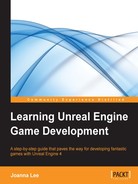Both DirectX and OpenGL are collections of application programming interfaces (APIs) used for handling multimedia information in a computer. They are the two most common APIs used today for video cards.
DirectX is created by Microsoft to allow multimedia related hardware, such as GPU, to communicate with the Windows system. OpenGL is the open source version that can be used on many operating system including Mac OS.
The decision to use DirectX or OpenGL APIs to program is dependent on operating system of the target machine.
Unreal Engine 4 was first launched using DirectX11. Following the announcement that DirectX 12 ships with Windows 10, Unreal has created a DirectX 12 branch from the 4.4 version to allow developers to start creating games using this new DirectX 12.
An easy way to identify APIs that are a part of DirectX is that the names all begin with Direct. For computer games, the APIs that we are most concerned about are Direct3D, which is the graphical API for drawing high performance 3D graphics in games, and DirectSound3D, which is for the sound playback.
DirectX APIs are integral in creating high-performance 2D and 3D graphics for the Windows operating system. For example, DirectX11 is supported in Windows Vista, Windows 7 and Windows 8.1. The latest version of DirectX can be updated through service pack updates. DirectX 12 is known to be shipped with Windows 10.
Direct3D 12 was announced in 2014 and has been vastly revamped from Direct3D 11 to provide significant performance improvement. This is a very good link to a video posted on the MSDN blog that shows the tech demo for DirectX 12: http://channel9.msdn.com/Blogs/DirectX-Developer-Blog/DirectX-Techdemo.
(If you are unfamiliar with Direct3D 11 and have not read the Shaders section earlier, read that section before proceeding with the rest of the DirectX section.)
If you can recall from the Shaders section, we have looked at the programmable pipeline for Direct3D 11. The following image is the same from the Shaders section (taken from MSDN) and it shows a series of programmable shaders:

In Direct3D 11, each of the stages is configurable independently and each stage is setting states on the hardware independently. Since many stages have the capability to set the same hardware state due to interdependency, this results in hardware mismatch overhead. The following image is an excellent illustration of how hardware mismatch overhead happens:

The driver will normally record these states from the application (game) first and wait until the draw time, when it is ready to send it to the display monitor. At draw time, these states are then queried in a control loop before they are is translated into a GPU code for the hardware in order to render the correct scene for the game. This creates an additional overhead to record and query for all the states at draw time.
In Direct3D 12, some programmable stages are grouped to form a single object known as pipeline state object (PSO) so that the each hardware state is set only once by the entire group, preventing hardware mismatch overhead. These states can now be used directly, instead of having to spend resources computing the resulting hardware states before the draw call. This reduces the draw call overhead, allowing more draw calls per frame. The PSO that is in use can still be changed dynamically based on whatever hardware native instructions and states that are required.

In Direct3D 11, work submission to the GPU is immediate. What is new in Direct3D 12 is that it uses command lists and bundles that contain the entire information needed to execute a particular workload.
Immediate work submission in Direct3D 11 means that information is passed as a single stream of command to the GPU and due to the lack of the entire information, these commands are often deferred until the actual work can be done.
When work submission is grouped in the self-contained command list, the drivers can precompute all the necessary GPU commands and then send that list to the GPU, making Direct3D 12 work submission a more efficient process. Additionally, the use of bundles can be thought of as a small list of commands that are grouped to create a particular object. When this object needs to be duplicated on screen, this bundle of commands can be "played back" to create the duplicated object. This further reduces computational time needed in Direct3D 12.
In Direct3D 11, the game creates resource views that bind these views to slots at the shaders. These shaders then read the data from these explicit bound slots during a draw call. If the game wants to draw using different resources, it will be done in the next draw call with a different view.
In Direct3D 12, you can create various resource views by using descriptor heaps. Each descriptor heap can be customized to be linked to a specific shader using specific resources. This flexibility to design the descriptor heap allows you to have full control over the resource usage pattern, fully utilizing modern hardware capabilities. You are also able to describe more than one descriptor heap that is indexed to allow easy flexibility to swap heaps, to complete a single draw call.
